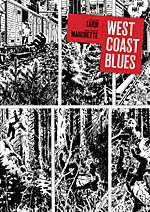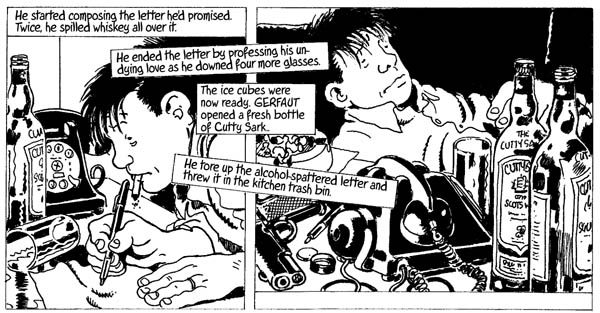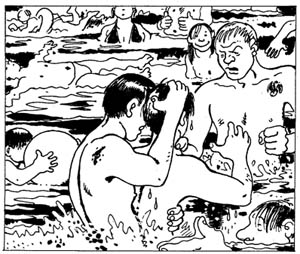 Adapted by Jacques Tardi
Adapted by Jacques Tardi
From the novel by Jean-Patrick Manchette
80 pages, black and white
Published by Fantagraphics
Until now, my only exposure to Jacques Tardi was the reprinting of some of his It Was the War of the Trenches stories in the pages of Drawn & Quarterly volume 2. It’s been fifteen years and those stories have still stuck with me, so when I heard about Fantagraphics’s plans to publish a line of Tardi’s books in English, I was pretty excited about the prospect. The first of Fantagraphics’s new Tardi reprints is West Coast Blues, a crime noir story adapted from a novel by Jean-Patrick Manchette. It’s a smart choice to lead the line. West Coast Blues is just the right mixture of action, suspense, and surprise to keep just about any reader’s attention.
Like so many noir stories, Manchette and Tardi start the story innocently enough. We meet the main characters, even though initially there’s no connection between George Gerfaut the salesman and Alonso Emerich y Emerich the crime boss. Even when the element that will connect them first appears—Gerfaut stopping to help a man in a car accident and dropping him off at the hospital—there’s no obvious link And, for a while, doom lingers over Gerfaut’s head as he and his family go about their everyday lives. It’s not until the book is a quarter of the way through that things finally erupt into a violent confrontation at a crowded beach, and from that point on things stay heated up.

What works so well about this progression is that we get a firm grasp on Gerfaut’s life, and all the things he likes and dislikes about it. It’s a staid, somewhat boring existence and completely different from the world where two speedo-clad assassins try to drown someone while surrounded by fellow swimmers. What makes that scene so striking is that Tardi never lets go of the fact that Gerfaut and his would-be killers are in broad daylight as this happens. You can always see children playing in the background, adults splashing about, sometimes even having people smiling in Gerfaut’s direction as they mistake attempted murder for horseplay in the ocean. Even Gerfaut himself thinks it’s a prank of some sort initially, angrily asking his wife if she was behind it. But as Gerfaut begins to really understand how much danger he’s in, things start to amp up in terms of intensity.
 By adapting the book into a graphic novel, Tardi is able to control the pacing of the story, devoting as much or as little time to different scenes as he wishes. With that in mind, I’m impressed with what Tardi does in West Coast Blues. As Gerfaut’s life goes into some unexpected places and situations, Tardi lingers on each new location for just the right amount of time to keep the reader slightly off-balance. It’s around the time that Gerfaut is lost in the Alps that I got the real feeling that anything could happen, and that guessing what would happen next was nothing short of an impossibility. And so, as Tardi and Manchette move forward, we get to see a very different life for Gerfaut slowly unfold away from the rest of the story, even as you know that sooner or later things will return from the main narrative with a vengeance.
By adapting the book into a graphic novel, Tardi is able to control the pacing of the story, devoting as much or as little time to different scenes as he wishes. With that in mind, I’m impressed with what Tardi does in West Coast Blues. As Gerfaut’s life goes into some unexpected places and situations, Tardi lingers on each new location for just the right amount of time to keep the reader slightly off-balance. It’s around the time that Gerfaut is lost in the Alps that I got the real feeling that anything could happen, and that guessing what would happen next was nothing short of an impossibility. And so, as Tardi and Manchette move forward, we get to see a very different life for Gerfaut slowly unfold away from the rest of the story, even as you know that sooner or later things will return from the main narrative with a vengeance.
It’s hard to ignore the strength of Tardi’s art in making West Coast Blues such a strong graphic novel. This is a book where blank backgrounds just aren’t acceptable; from bottles on the table to the buildings along the streets of Paris, every scene is carefully rendered in Tardi’s trademark style. The more you look at each scene, the more deliberate everything appears; the young mother pushing a stroller down the street as Gerfaut enters his apartment under the watch of the assassins, or the swerving through Parisian traffic with its narrow misses. It’s all beautifully drawn, with rounded faces and features on the characters. There are some especially nice touches for the observant; the fact that the assassins always have the same impassive looks on their faces, for instance, even while all other characters show a wide range of emotion. Or, for that matter, the fact that one of the two assassins never has time to change after the hit on the beach and continues to wear his speedo in scenes quite far from the coast. Tardi’s also able to bring to life some of the scenes through his art in a way that the narration alone can’t. So when Gerfaut mentions feeling less lost when he finally escapes the forest, the art moves from a claustrophobic jumble of vegetation to a wide-open expanse of grassland. Even though the reality of Gerfaut’s relative safety is there if you think about it, just seeing all that open space makes even the reader feel like Gerfaut’s made some huge accomplishment.
West Coast Blues is a sharp, beautiful book. With another Tardi book around the corner (You Are There) and the complete It Was The War of the Trenches scheduled for early 2010, it’s a real pleasure to see Tardi’s works taken care of in such a manner. I feel a little guilty for having not pursued Tardi’s works more in the past fifteen years, but on the plus side it was well worth the wait. For people looking for a noir thriller, you’ve come to the right place.
Purchase Links: Amazon.com | Powell’s Books
